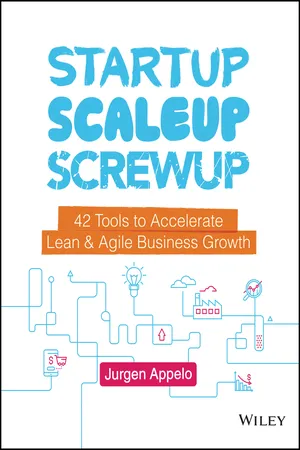
Startup, Scaleup, Screwup
42 Tools to Accelerate Lean and Agile Business Growth
- English
- ePUB (mobile friendly)
- Available on iOS & Android
About This Book
Real-world tools to build your venture, grow your business, and avoid mistakes
Startup, Scaleup, Screwup is an expert guide for emerging and established businesses to accelerate growth, facilitate scalability, and keep pace with the rapidly changing economic landscape. The contemporary marketplace is more dynamic than ever before—increased global competition, the impact of digital transformation, and disruptive innovation factors require businesses to implement agile management and business strategies to compete and thrive. This indispensable book provides business leaders and entrepreneurs the tools and guidance to meet growth and scalability challenges head on.
Equal parts motivation and practical application, this book answers the questions every business leader asks from the startup ventures to established companies. Covering topics including funding options, employee hiring, product-market validation, remote team management, agile scaling, and the business lifecycle, this essential resource provides a solid approach to grow at the right pace and stay lean. This book will enable you to:
- Apply 42 effective tools to sustain and accelerate your business growth
- Avoid the mistakes and pitfalls associated with rapid business growth or organizational change
- Develop a clear growth plan to integrate into your overall business model
- Structure your business for rapid scaling and efficient management
Startup, Scaleup, Screwup: 42 Tools to Accelerate Lean & Agile Business Growth is a must-read for entrepreneurs, founders, managers, and senior executives. Author Jurgen Appelo shares his wisdom on the creative economy, agile management, innovation marketing, and organizational change to provide a comprehensive guide to business growth. Practical methods and expert advice make this book an essential addition to any business professional's library.
Frequently asked questions
1
Persistence of Vision
Inspire team members, customers, and investors with a Product Vision: a mental image of your desired future.



We defined the opportunity ahead of us in a way that scales globally. There are 1.2 billion students in the world and every student needs help learning every day. If we think about the problem that Brainly is solving, it’s that big problem. Quite often, what I see is that the problems that startups are trying to solve are not big enough. They are chasing an opportunity that is way smaller than the real opportunity that is ahead of them. It was the same for us early on. We started in Poland. We were initially not thinking about our global opportunity. We were just thinking about our own country. It took us about three years to really figure out why we are here and what we are trying to achieve. Now that it’s clearly defined, it helps me to manage the company towards that vision. I would encourage every startup founder and CEO to think about their big vision way earlier than we have done.Michał Borkowski, founder and CEO of Brainly, Kraków, Poland

When I look at all the dozens or hundreds of startups that went by, the great ones have something that the others don’t. There is one thing that makes all the difference. The best founders have a True North. They have some sort of clock ticking in them that they want to solve a huge problem. But then, in what way and how and to which customers, that’s not certain yet. They are willing to be flexible, as long as they can make progress toward their vision. That’s, by far, the biggest differentiator.Marc Wesselink, managing partner at Startupbootcamp, Amsterdam, The Netherlands

Our founder wanted us to help Finnish people be more social at business-to-business events and bring them together. In today’s very digital world, if the face-to-face contacts are well-facilitated and they are matched around common interests, and the environment is fun and engaging, people can generate good business. They can make new contacts. They can get new ideas. Maybe they even get their problems solved. That’s what our founder wanted, so that’s where our vision lies. And we’re happy that we have made good progress toward that vision.Jenni Tolonen, CEO at Management Events, Helsinki, Finland

Table of contents
- Cover
- Title Page
- Copyright
- Dedication
- Prologue
- 1 Persistence of Vision
- 2 Stories of Your Life and Others
- 3 Picking Up the Pieces
- 4 The Persona Protocol
- 5 Fortune’s Wheel
- 6 The Crowded Shadows
- 7 The Lunatic Cafe
- 8 Streams of Silver
- 9 The Invention of Everything Else
- 10 The Terminal Experiment
- 11 Fables and Reflections
- 12 Kings of the North
- 13 The Entropy Tango
- 14 A Pleasure to Burn
- 15 The New Recruit
- 16 The Enigma Score
- 17 Standard Hero Behavior
- 18 The Darkest Road
- 19 Ghost Writer in the Sky
- 20 Million-Dollar Gamble
- 21 Spheres of Influence
- 22 Heart Journey
- 23 A Pirate’s Tale
- 24 Test of the Twins
- 25 Culture Clash
- Epilogue
- Acknowledgments
- About the Author
- Index
- End User License Agreement